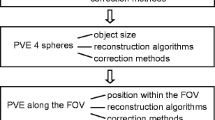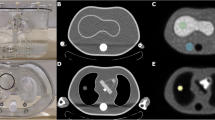Abstract
In positron emission tomographic (PET) scanning, transmission measurements for attenuation correction are commonly performed by using external germanium-68 rod sources. Recently, combined PET and computed tomographic (CT) scanners have been developed in which the CT data can be used for both anatomical-metabolic image formation and attenuation correction of the PET data. The purpose of this study was to evaluate the difference between germanium- and CT-based transmission scanning in terms of their radiation doses by using the same measurement technique and to compare the doses that patients receive during brain, cardiac and whole-body scans. Measurement of absorbed doses to organs was conducted by using a Rando Alderson phantom with thermoluminescent dosimeters. Effective doses were calculated according to the guidelines in the International Commission on Radiation Protection Publication Number 60. Compared with radionuclide doses used in routine 2-[fluorine-18]-fluoro-2-deoxy-d-glucose PET imaging, doses absorbed during germanium-based transmission scans were almost negligible. On the other hand, absorbed doses from CT-based transmission scans were significantly higher, particularly with a whole-body scanning protocol. Effective doses were 8.81 mSv in the high-speed mode and 18.97 mSv in the high-quality mode for whole-body CT-based transmission scans. These measurements revealed that the doses received by a patient during CT-based transmission scanning are more than those received in a typical PET examination. Therefore, the radiation doses represent a limitation to the generalised use of CT-based transmission measurements with current PET/CT scanner systems.

Similar content being viewed by others
References
Bailey DL. Transmission scanning in emission tomography. Eur J Nucl Med 1998; 25:774–787.
Lonneux M, Borbath I, Bol A, et al. Attenuation correction in whole-body FDG oncological studies: the role of statistical reconstruction. Eur J Nucl Med 1999; 26:591–598.
Bengel FM, Ziegler SI, Avril N, Weber W, Laubenbacher C, Schwaiger M. Whole body positron emission tomography in clinical oncology: comparison between attenuation corrected and uncorrected images. Eur J Nucl Med 1997; 24:1091–1098.
Visvikis D, Costa DC, Croasdale I, Lonn AHR, Bomanji J, Gacinovic S, Ell PJ. CT-based attenuation correction in the calculation of semi-quantitative indices of [18F]FDG uptake in PET. Eur J Nucl Med Mol Imaging 2003; 30:344–353.
Kluetz PG, Meltzer CC, Villemagne VL, et al. Combined PET/CT imaging in oncology: impact on patient management. Clin Positron Imaging 2000; 3:223–230.
Charron M, Beyer T, Bohnen NN, et al. Image analysis in patients with cancer studied with a combined PET and CT scanner. Clin Nucl Med 2000; 25:905–910.
Townsend DW. A combined PET/CT scanner: the choices. J Nucl Med 2001; 42:533–534.
Israel O, Mor M, Gaitini D, et al. Combined functional and structural evaluation of cancer patients with a hybrid camera-based PET/CT system using18F-FDG. J Nucl Med 2002; 43:1129–1136.
Kamel EM, Goerres GW, Burger C, von Schulthess GK, Steinert HC. Recurrent laryngeal nerve palsy in patients with lung cancer: detection with PET-CT image fusion—report of six cases. Radiology 2002; 224:153–156.
Kamel E, Hany TF, Burger C, et al. CT vs68Ge attenuation correction in a combined PET/CT system: evaluation of the effect of lowering the CT tube current. Eur J Nucl Med Mol Imaging 2002; 29:346–350.
Nakamoto Y, Osman M, Cohade C, Marshall LT, Links JM, Kohlmyer S, Wahl RL. PET/CT: comparison of quantitative tracer uptake between germanium and CT transmission attenuation-corrected images. J Nucl Med 2002; 43:1137–1143.
Beyer T, Townsend DW, Brun T, et al. A combined PET/CT scanner for clinical oncology. J Nucl Med 2000; 41:1369–1379.
Hany TF, Steinert HC, Goerres GW, Buck A, von Schulthess GK. PET diagnostic accuracy: improvement with in-line PET-CT system: initial results. Radiology 2002; 225:575–581.
Cao Z, Tsui BM. Performance characteristics of transmission imaging using a uniform sheet source with parallel hole collimaton. Med Phys 1992; 19:1205–1212.
Prvulovich EM, Lonn AHR, Bomanji JB, Jarrit PH, Ell PJ. Effect of attenuation correction on myocardial thallium-201 distribution in patients with a low likelihood of coronary artery disease. Eur J Nucl Med 1997; 24:266–275.
Hashimoto J, Kubo A, Ogawa K, Amano T, Fukuuchi Y, Motomura N, Ichiara T. Scatter and attenuation correction in technetium-99m brain SPET. J Nucl Med 1997; 38:157–162.
Almeida P, Bendriem B, de Dreuille O, Peltier A, Perrot C, Brulon V. Dosimetry of transmission measurements in nuclear medicine: a study using anthropomorphic phantoms and thermoluminescent dosimeters. Eur J Nucl Med 1998; 25:1435–1441.
Burger C, Goerres G, Schoenes S, Buck A, Lonn AHR, von Schulthess GK. PET attenuation coefficients from CT images: experimental evaluation of the transformation of CT into PET 511 keV attenuation coefficients. Eur J Nucl Med Mol Imaging 2002; 29:922–927.
Deloar HM, Fujiwara T, Shidahara M, Nakamura T, Yamadera A, Itoh M. Internal absorbed dose estimation by a TLD method for18F-FDG and comparison with dose estimates from whole body PET. Phys Med Biol 1999; 44:595–606.
Jurik AG, Jensen LC, Hansen J. Radiation dose by spiral CT and conventional tomography of the sternoclavicular joints and the manubrium sterni. Skeletal Radiol 1996; 25:467–470.
ICRP Publication Number 60. Recommendations of the International Commission on Radiation Protection. Oxford: Pergamon Press, 1990.
Deloar HM, Fujiwara T, Shidahara M, et al. Estimation of absorbed dose for 2-[F-18]fluoro-2-deoxy-d-glucose using whole-body positron emission tomography and magnetic resonance imaging. Eur J Nucl Med 1998; 25:565–574.
Dowd MT, Chen CT, Wendel MJ, et al. Radiation dose to the bladder wall from 2-[18F]-Fluoro-2-deoxy-d-glucose in adult humans. J Nucl Med 1991; 32:707–712.
Thomas SR, Stabin MG, Chen CT, Samaratunga RC. A dynamic urinary bladder model for radiation dose calculations. MIRD pamphlet No 14, revised. J Nucl Med 1999; 40:102S–123S.
Wu TH, Liu RS, Dong SL, Chung YW, Chou KL, Lee JS. Dynamic evaluation of absorbed dose to the bladder wall with a balloon-bladder phantom during a study using [18F]fluorodeoxyglucose positron emission imaging. Nucl Med Commun 2002; 23:749–755.
Visvikis D, Cheze-LeRest C, Costa DC, Bomanji J, Gacinovic S, Ell PJ. Influence of OSEM and segmented attenuation correction in the calculation of standardised uptake values for [18F]FDG PET. Eur J Nucl Med 2001; 28:1326–1335.
Xu EZ, Mullani NA, Gould LK, Anderson WL. A segmented attenuation correction for PET. J Nucl Med 1991; 32:161–165.
Acknowledgements
This study was financially supported by the Program for Promoting Academic Excellence of Universities (89-B-FA22-1-4-05) of the Ministry of Education of Taiwan.
Author information
Authors and Affiliations
Corresponding author
Rights and permissions
About this article
Cite this article
Wu, TH., Huang, YH., Lee, J.J.S. et al. Radiation exposure during transmission measurements: comparison between CT- and germanium-based techniques with a current PET scanner. Eur J Nucl Med Mol Imaging 31, 38–43 (2004). https://doi.org/10.1007/s00259-003-1327-6
Received:
Accepted:
Published:
Issue Date:
DOI: https://doi.org/10.1007/s00259-003-1327-6




